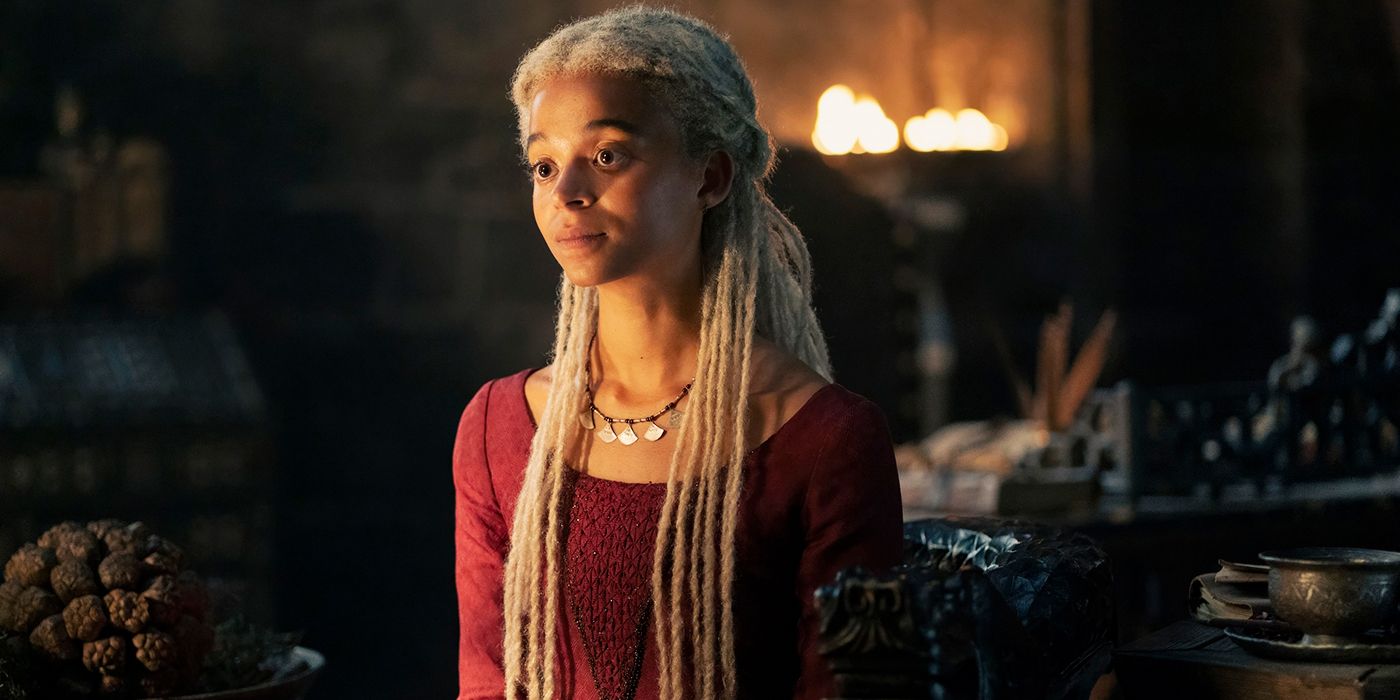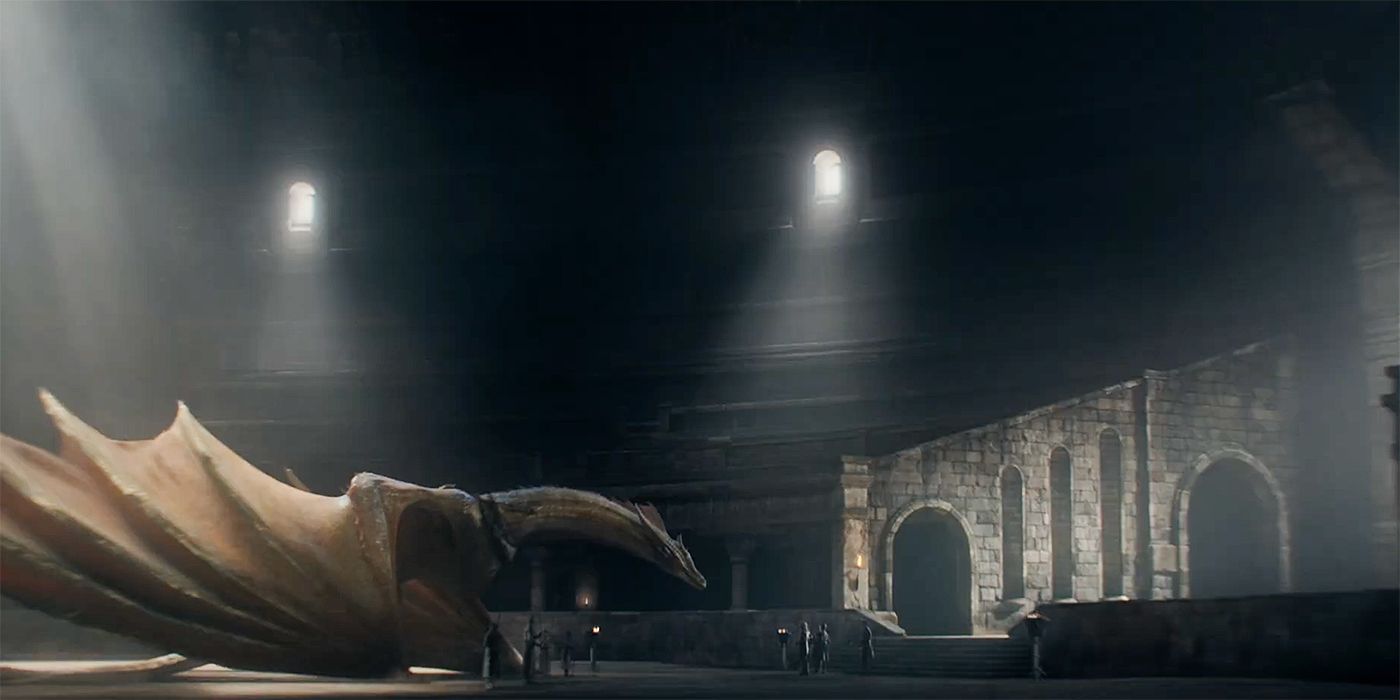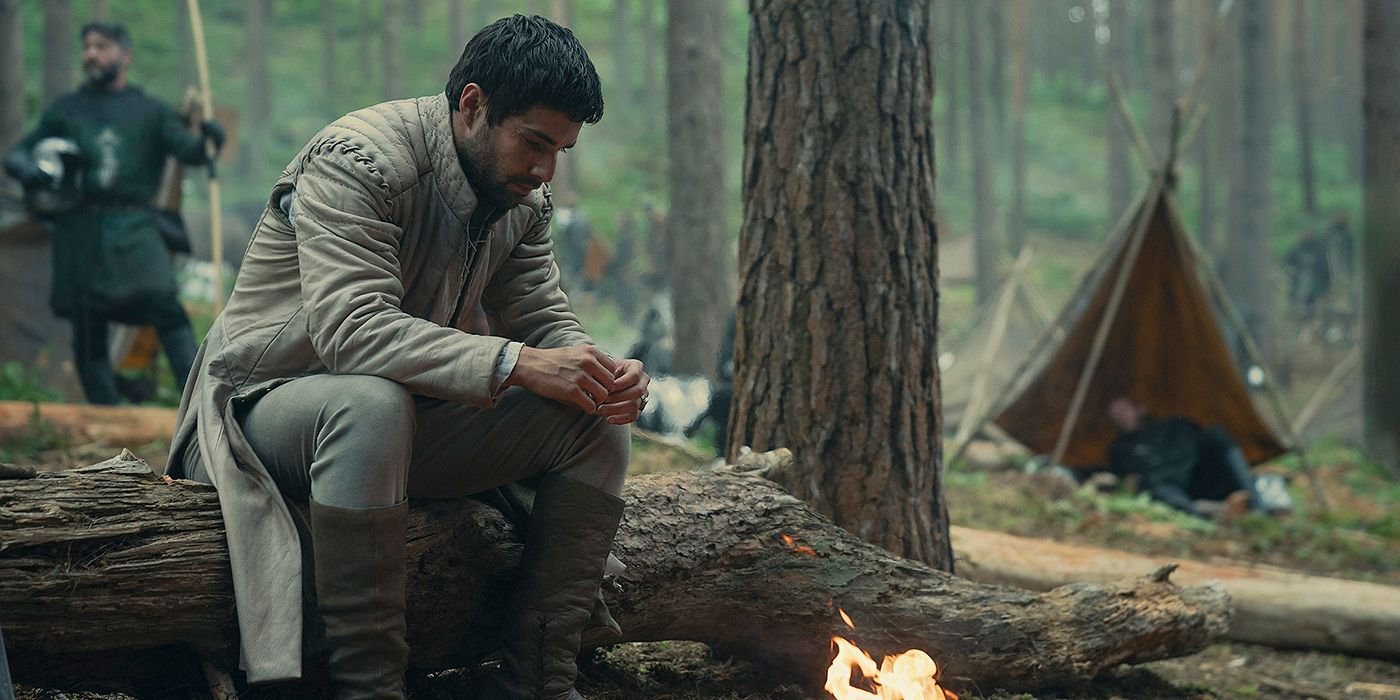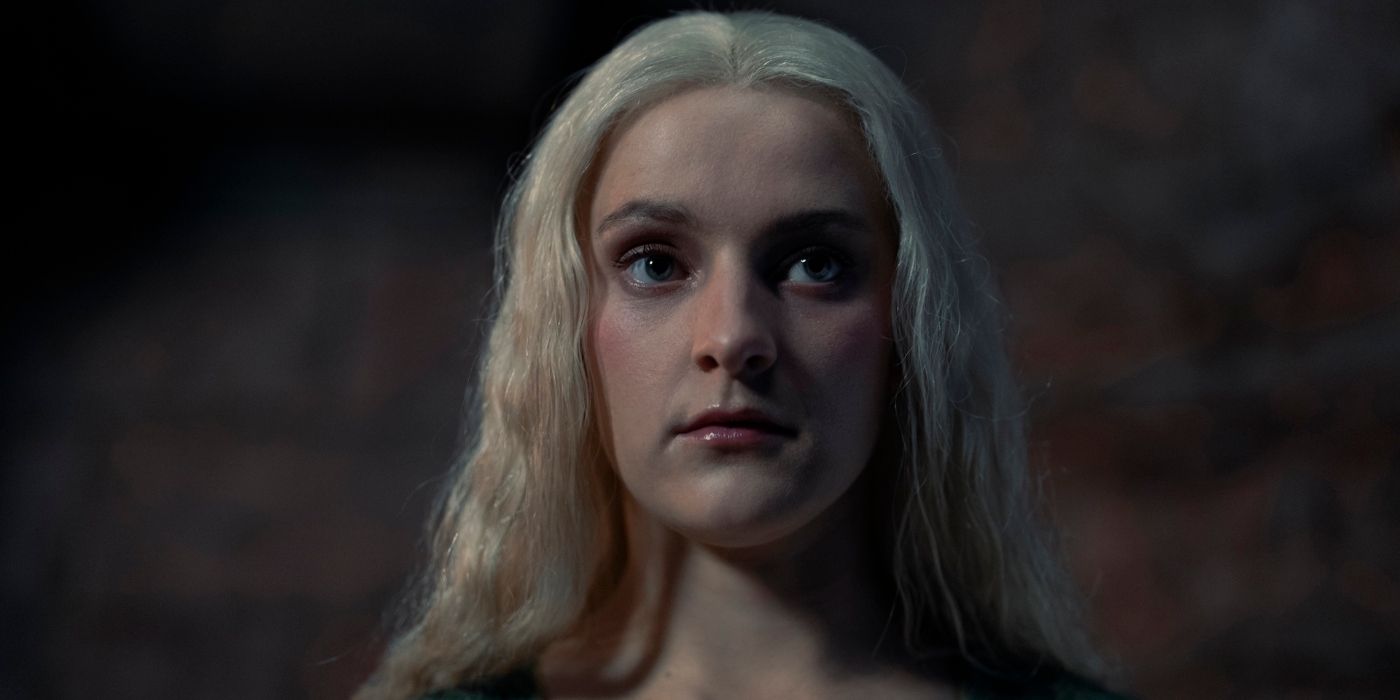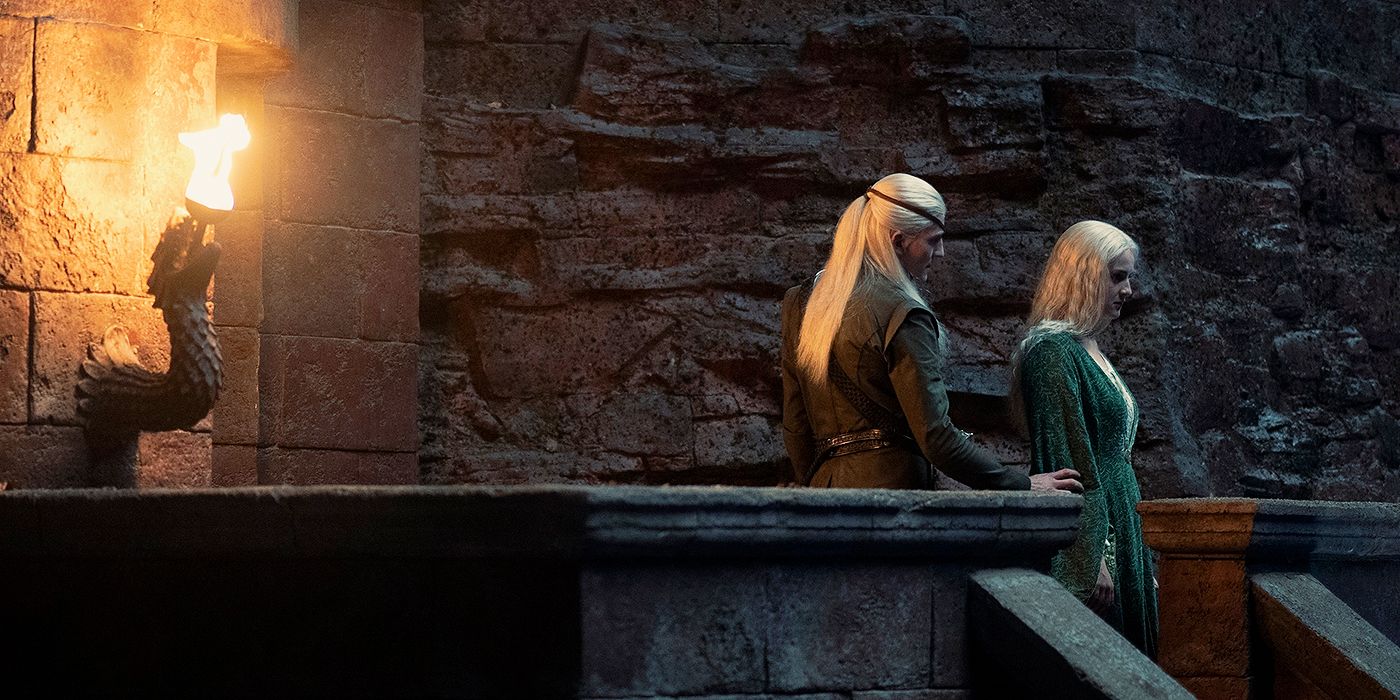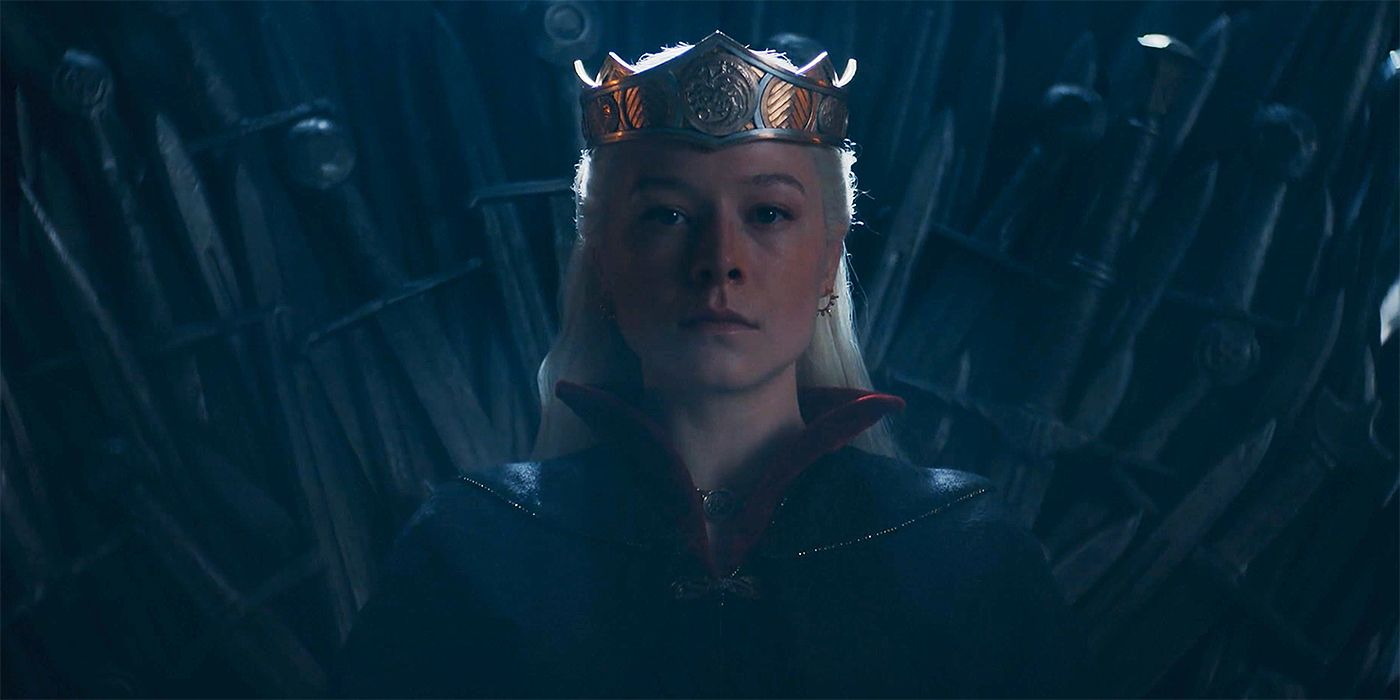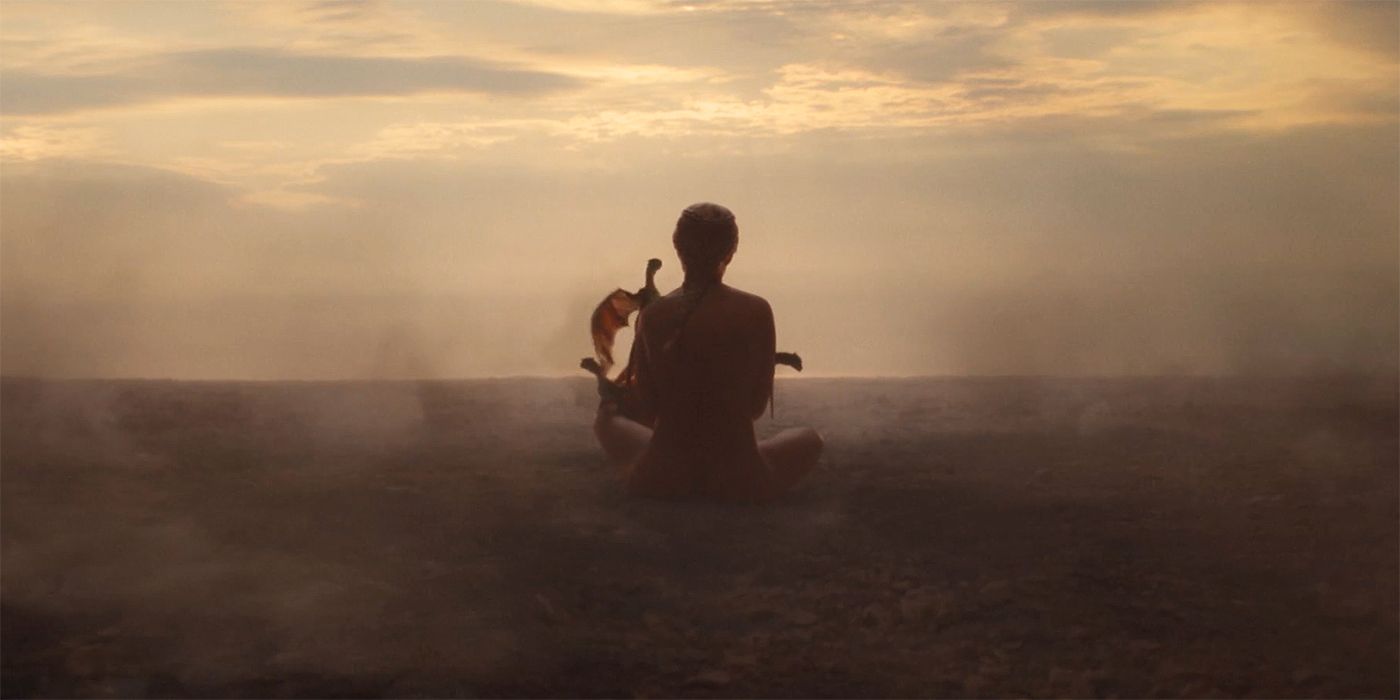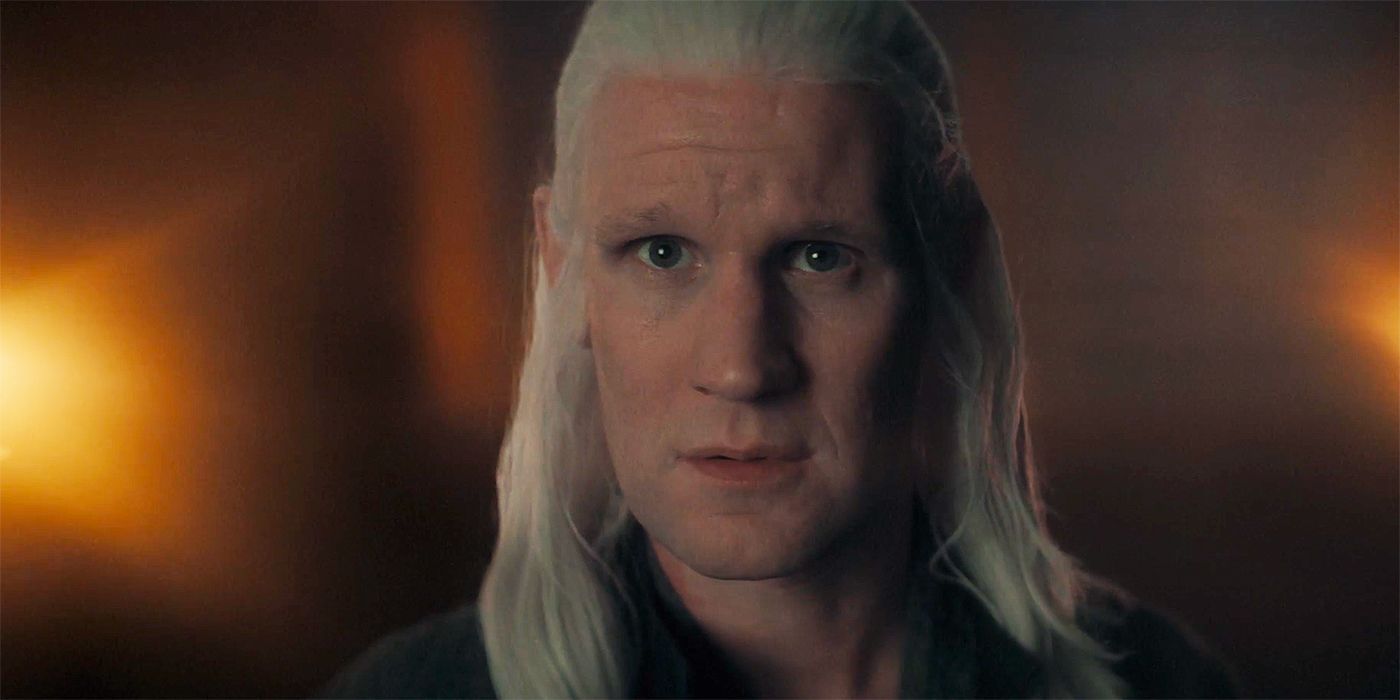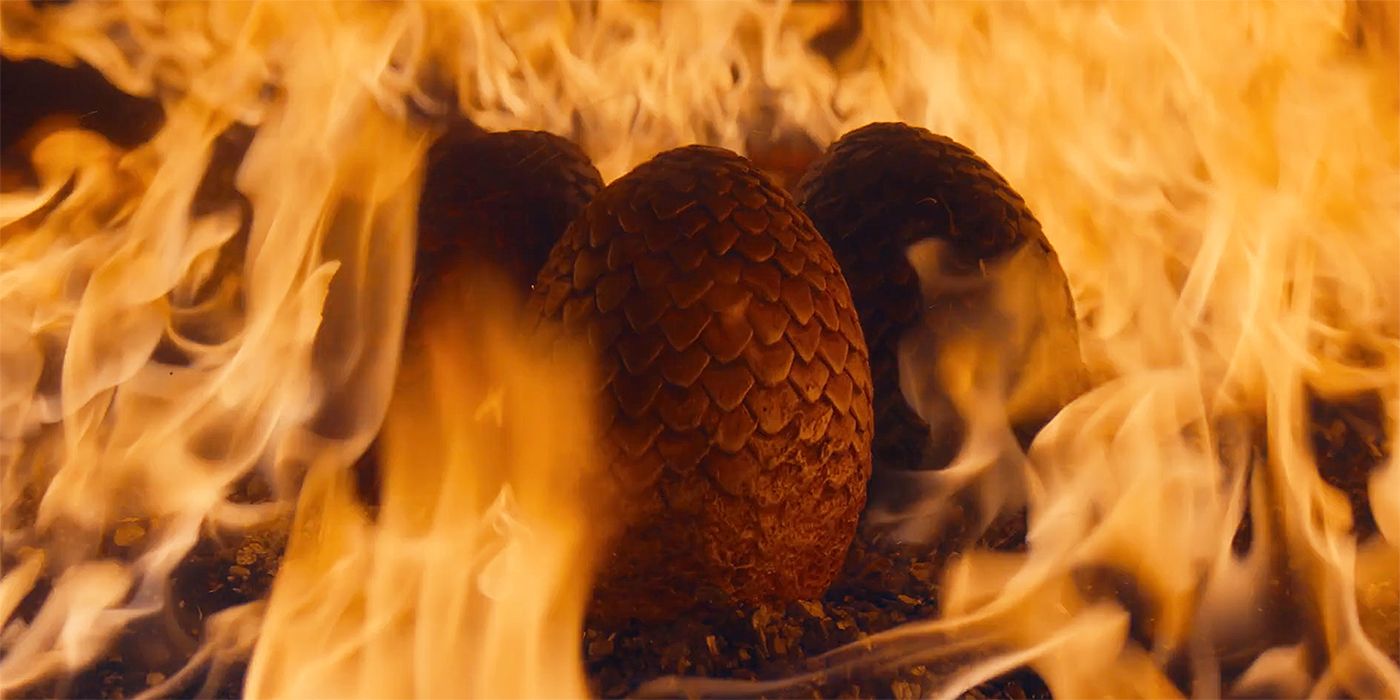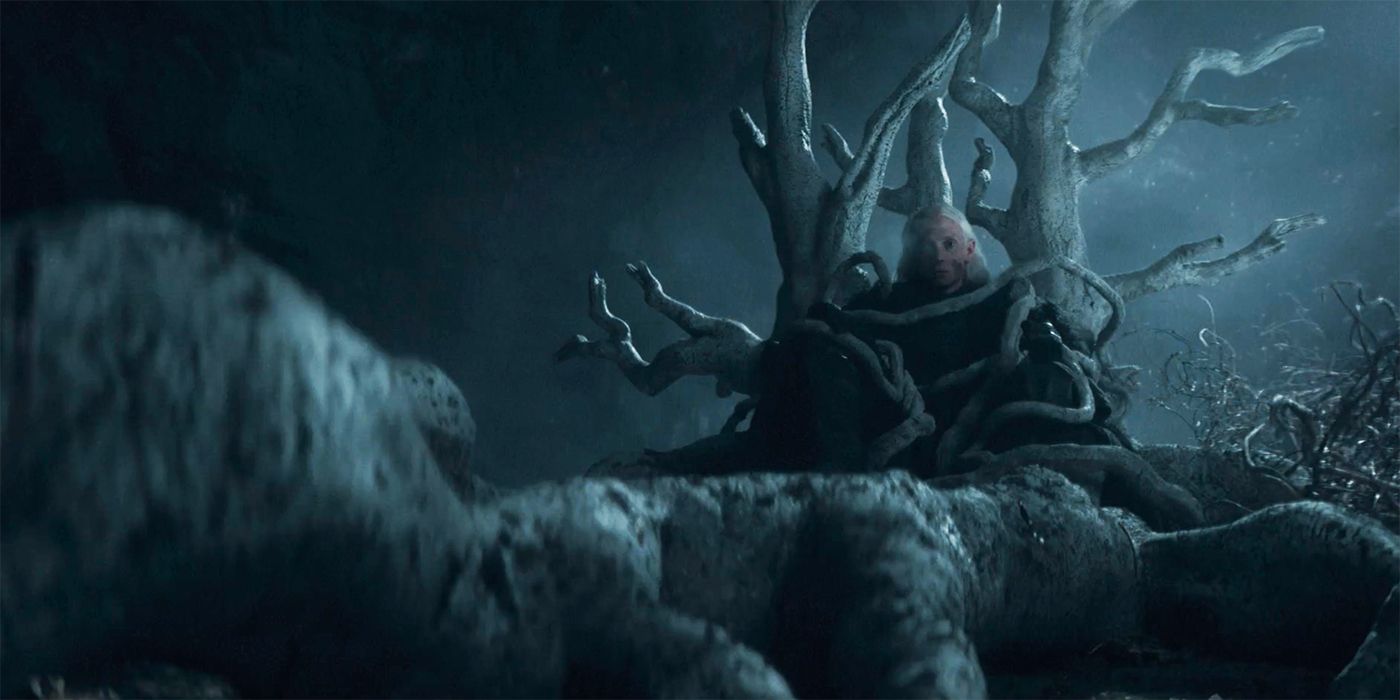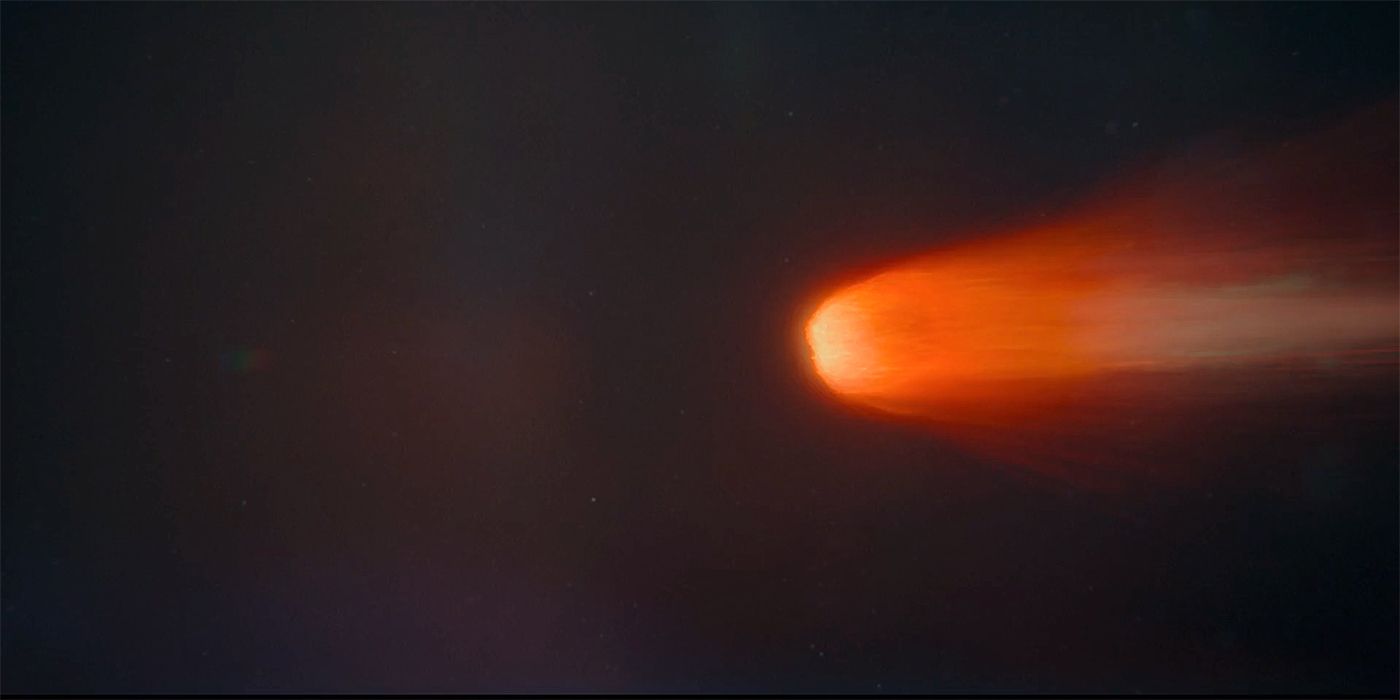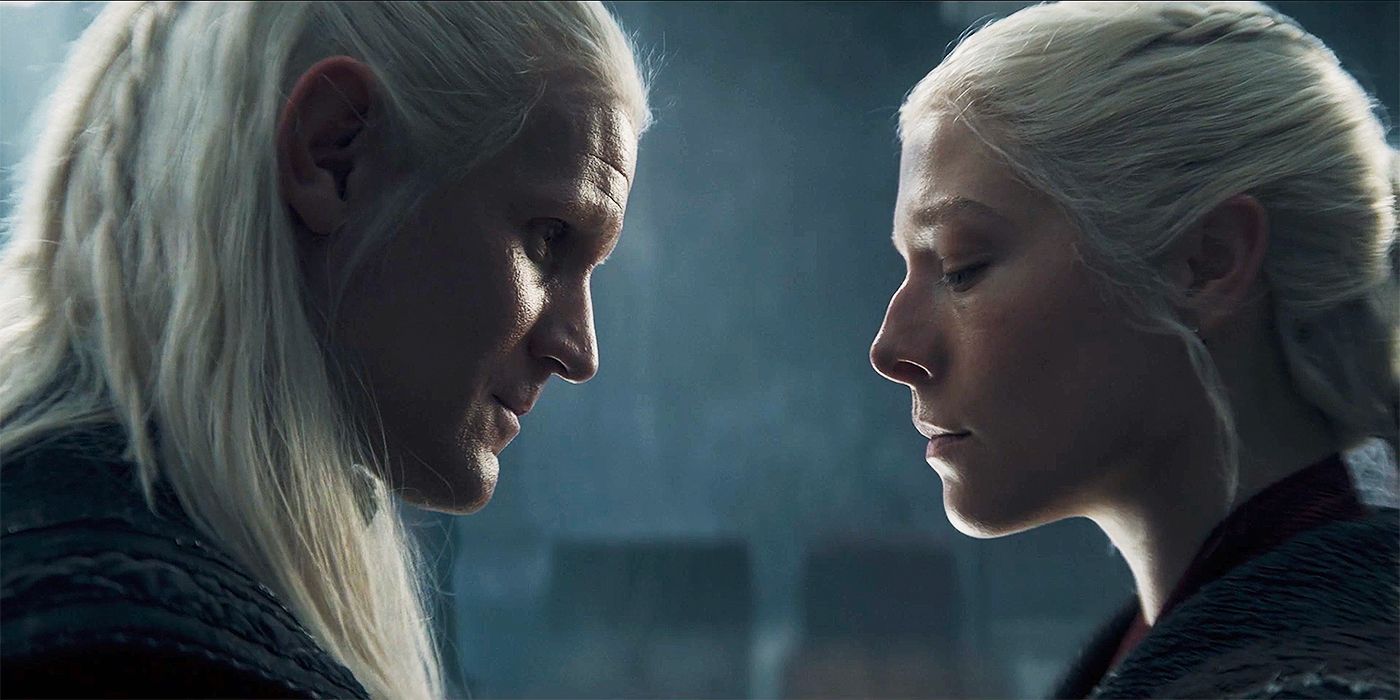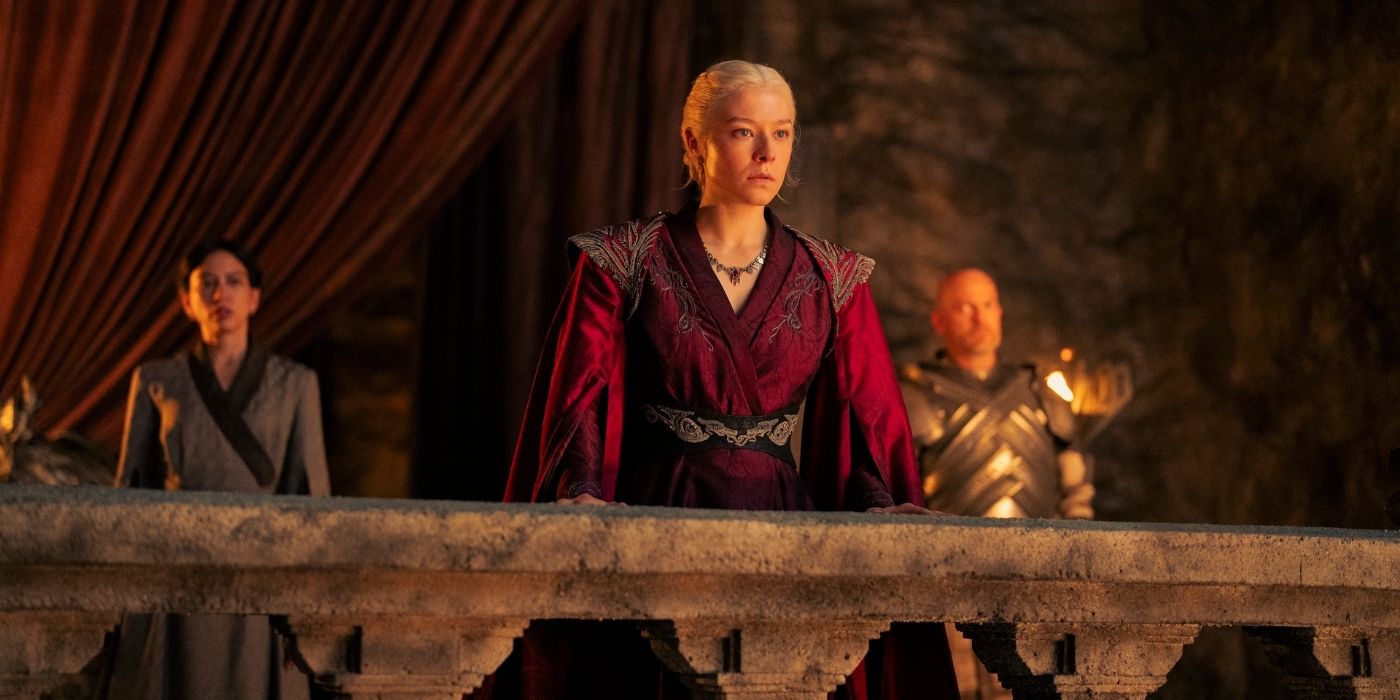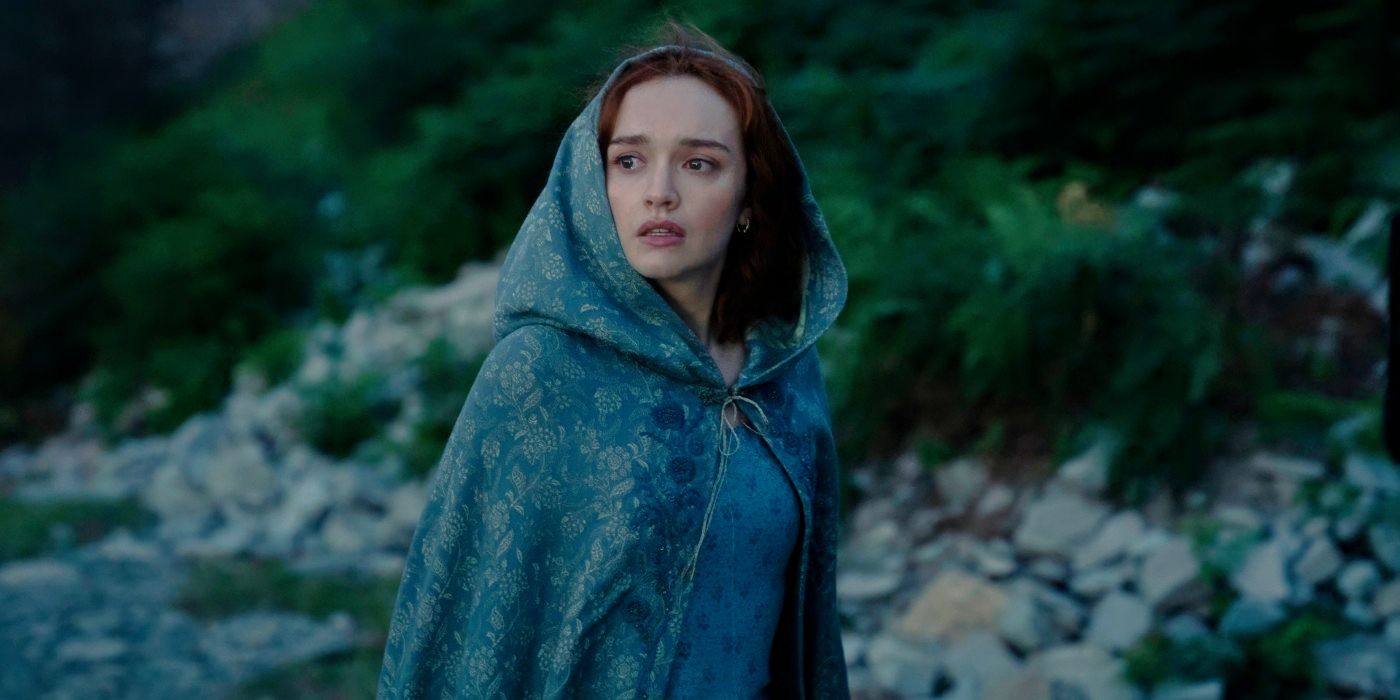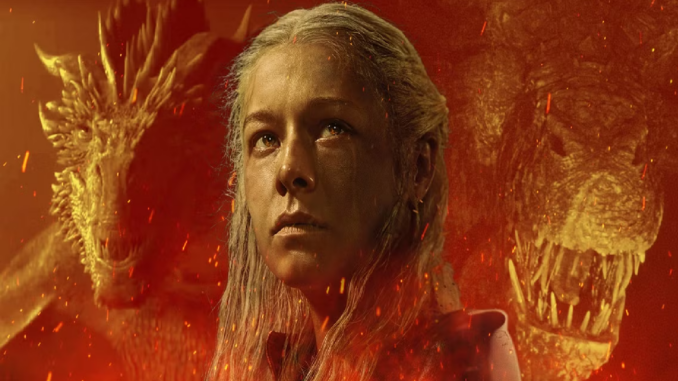
House of the Dragon Season 2 just had its finale which saw the armies of Westeros marching toward war from all corners of the map. The Game of Thrones prequel series has been building toward this moment all season, but the finale not only concluded some of the major arcs of the season but also laid the groundwork for Season 3. We saw Daemon ( Matt Smith) finally bend the knee and publicly pledge his loyalty to Rhaenyra (Emma D’Arcy) after having a vision of White Walkers and Daenerys. We also saw Rhaena (Phoebe Campbell) discover a wild dragon in the Vale after running from the group meant to take her to Pentos. Aegon ( Tom Glynn-Carney) and Larys (Matthew Needham) went on the run, while Aemond (Ewan Mitchell) confronted Helaena (Phia Saban) about riding her dragon into the war only to be rebuffed by her. And, in the final moments, we saw Alicent (Olivia Cooke) sneak into Dragonstone to make a plea for peace with Rhaenyra, only to sell out her sons in exchange for her and Helaena’s escape.
Moderated by Joanna Robinson, showrunner Ryan Condal answered our burning questions about the season finale during a press conference this Monday morning. Condal answered questions about the future Battle of the Gullet, Rhaena being given Nettles’ storyline, the status of Aegon’s dragon Sunfyre, Criston Cole’s perspective on the war, Helaena and Daemon’s visions, Rhaenyra’s interpretation of the prophecy, and that final scene between Rhaenyra and Alicent.
Ryan Condal Teases the Biggest Fight to Date in Season 3
One of the biggest things that the Season 2 finale teased is what will eventually be known as the Battle of the Gullet. It is a massive fight, and Condal explained that these sequences require a lot of effort, money, and time. As a showrunner, he says, “You’re always in the position of having to balance storytelling and the resources that you have available to tell that story.” Season 2 only had one major battle scene, something that some viewers found to be a disappointment considering the legendary battle scenes of Game of Thrones, but Condal explained that the show had to be “rebalanced” so that the future seasons could tell a more rounded out story.
“We were trying to give the Gullet, which I would say is maybe the second most anticipated action event of Fire & Blood , trying to give it the time and the space that it deserves. Obviously, as anybody that’s seen the finale, we are building to that. That event will happen very shortly in terms of the storytelling of House of the Dragon . It should be, I mean, based on what we know now, it should be the biggest thing to date that we’ve pulled off , and we just wanted to have the time and the space to do that at a level that is going to excite and satisfy the fans in the way it’s deserved. And we also wanted to build some anticipation toward it. I know everybody wants this to come out every summer. It’s just that the show is so complex that we’re really making multiple feature films every season . So I apologize for the wait, but I will just say if Rook’s Rest and the Red Sowing are any indication, the team that we have together, we’re gonna pull off a hell of a win with the Battle of the Gullet in the future.”
Has Nettles Been Replaced by Rhaena in ‘House of the Dragon’?
When it comes to book characters, it’s hard to imagine a character some fans are clamoring for louder than the dragonseed Nettles. Although the character was not cast for Season 2, and it looks like Rhaena will be claiming her dragon, Sheepstealer, Condal did not fully confirm the fact that Nettles has been cut.
“Given where we are in the storytelling, I think that’s a, ‘Please stay tuned and keep watching the story.’ I will say that we love Rhaena as a character, and we’ve really done a lot of legwork to set her up from the beginning as somebody in this Targaryen household who does not have a dragon. We saw that with Aemond’s story of how somebody that grows up in this family, even in a time of peace, when you don’t have a dragon, how it changes how you’re identified even within the family. And how desperate Rhaena is for that sort of self-identification as a dragon rider , and is willing to go to fairly dangerous lengths to try to see that realized.”
Condal also went on to specify that although House of the Dragon is based on George R. R. Martin‘s book Fire & Blood, that does not mean that the show is the definitive truth of the accounts of the Dance of Dragons. Specifying that changes are not made lightly when adapting the fictional history book to screen.
“I think part of the fun of adapting Fire & Blood is how we interpret the accepted history that these three different historians sometimes argue about and wrote down and, you know, we’re not trying to tell the objective truth . We’re providing the television version of one objective truth of this history, and anybody who reads the book is free to interpret it however they want to. But there are a lot of paths to interpretation through this . And I think the Rhaena story as we’re seeing it unfold is potentially one of those interesting interpretations that we have to offer, and I would just say that we don’t do any of this stuff lightly or without thought. Many of these things, we’ve planned many seasons in advance. So I would just say, you know, buckle up and take the ride with us. And hopefully, you like the destination it’s going to.”
Is Aegon’s Dragon, Sunfyre, Actually Dead?
The Season 2 finale also highlighted something that had book readers scratching their heads. A couple of characters mention that Aegon’s dragon, Sunfyre, is dead. However, without spoiling too much of the end of the story, Sunfyre plays a pretty pivotal role even as an injured dragon. When asked to clarify on Sunfyre’s status, Condal avoided answering the question directly and instead focused on how he and executive producer Sara Hess went about interpreting and adapting scenes from Fire & Blood.
“It’s a very tricky position to be in my seat/our seat, Sara [Hess] and I, as custodians of this world, we have to render an exciting television adaptation of this story, knowing that there’s always going to be a percentage of this gigantic TV audience that has not read the book, and a percentage that has read the book very closely, and we’re constantly in this trying to serve both worlds. We’re trying to make a well-rounded, exciting television show with deep and well-realized characters, but also serve faithfully this book that George wrote that we both love and we understand is beloved by the fans, and do it in a way that both those things kind of can exist and live in harmony to harmony together. We understand that that’s not always possible from decision to decision, but the hope is that overall, at the end of this, this is regarded as a faithful rendering of Fire & Blood .
What I will say is that we are not looking to do anything for shock value or to totally change the way the history was written . What I think we need to do as adapters and storytellers in television is to interpret things in new and unexpected ways that are given to you one way in the book. There’s a line in the book that says X, and then we are presenting you with this very well-rounded, three-dimensional story that’s told from all the different points of view, that gives you a deeper understanding of why that thing was written down in the history, why it was accepted by the history. And those are more the things that I think we’re interested in doing and trying to do. And frankly, we take on as a charge of ours as dramatists, you have to provide depth and layering to this book, which often, intentionally, only gives you a very surface view of a historical event, or sometimes says we don’t know why this happened we just know that point A is here and point C is here. We don’t know what B was. And some of that is the most fun for us, because then we can really just, we get to invent B and as long as A and C agree, then, then we feel like we’re good, but stay tuned, I would say, on all of the dragon drama to come.”
Criston Cole’s Perspective on the War Has Entirely Shifted
Though we mostly follow dragonriders, Criston Cole (Fabien Frankel) is unique in that he is not only not a dragonrider, but he is merely the son of a steward. We watched in Season 2 as he rose from Commander of the Kingsguard to become Hand of the King and to leading the armies of the Greens on a campaign in the Crownlands. However, after the battle of Rook’s Rest, Criston’s perspective on war has completely changed. Condal discussed where Criston thinks he falls in the grand scheme of things and what the character thinks his own fate will be.
“I think Criston’s in a dark place at the end of this season , and understandably, I mean, he’s marched off, he’s going off to link up with Vhagar, knowing that if that happens, that the men on the ground, as they were at Rook’s Rest, are the cannon fodder, even the knights on horseback, even the reserves of the cavalry. We’ve given the war to the dragons. And I think he’s realized and processed his own role in that, not only where his end is likely to be, which is not a pleasant one, but also where the end of this entire war is to be, as somebody that understands, on a strategic level, how warfare works and how this thing is going to play out, and he’s seen it on a micro and macro scale, at Rook’s Rest. We saw him march off at the end of Episode 6, back into the breach. And I don’t think there’s any reason for Cole to believe, given what we know about him, that he’s going to come home from that.”
Condal went on to praise Frankel’s performance in the season and also compared Criston to Game of Thrones fan favorite, Jaime Lannister (Nikolaj Coster-Waldau) in that Criston “forces people to take a little bit of a different look at Cole, who I think many people have prejudged over the course of the season.”
Helaena’s Power of Prophecy Makes Her Unique From the Other Targaryens
Season 2 saw Helaena suffering through one of the greatest tragedies of the series in the opening episode, but by the finale she has fully realized her visions and is unafraid to confront her brother Aemond when he asks her to go to war. Condal referred to Helaena’s book character as a “tabula rasa” compared to her brothers. He referred back to Season 1 and Viserys’ (Paddy Considine) obsession with prophecy and the book character Daenys the Dreamer when talking about Helaena.
“We love this idea that, you know, Viserys, he saw the dragons as this dangerous thing that the Targaryens had to contend with, this nuclear power that we possess, and we need to be careful with, and we wield it to hold power and to keep things united, but we have to take care not to wield it, to take it too far, because that way leads to doom the way it did in Valyria. And the real power, he saw in the family, was this power that Daenys the Dreamer had, the power of prophecy and Targaryen foresight, arguably the thing that made them special . Everybody had dragons in Old Valyria, but she was the one who had this dream that preserved them from the fate that fell every other Dragonlord family, and this idea that Viserys was so obsessed with it, he wanted so desperately to be a dreamer himself that either did or did not have this dream that told him that Baelon was going to be born to him and sit on the throne all the things he tells Aemma and then Alicent in Season 1. And the idea that Helena, his daughter, right under his very nose, had this power that everybody kind of ignored because they view her as different or odd or just, ‘Oh, that’s just Helena.’ But now people are starting to take a little bit more care and notice of her.”
Condal added that Helaena’s abilities are evolving. Before, it seemed to be that Helaena’s visions were confusing to her until she actually saw them come to fruition. Rather than seeing the future clearly, she was only able to understand the truth after the event happened. This season, however, her interpretation of her visions have improved due to the loss of her son and the trauma she experienced with Blood and Cheese.
“Yeah, I think she’s evolving, and also there’s been extreme psychological pressure put on her, not only with the massive loss that she had early in the season but just the stress of living in this chaotic environment. And I think it’s, we know this from anybody that’s read into people that have psychic experiences or things like that, or people that seem to be a medium that can, like, read into things or experience a haunting. Moments of physical stress can bring those things out in a more pronounced way , whether you believe in any of that or not. And I think you’re seeing Helena, she’s not just going to, from the beginning of her life to the end, have the same sort of level of grasp of this ability. We’re seeing it certainly change a little bit.”
What Was Aemond’s Reaction To Being Told About His Own Death?
The finale didn’t beat around the bush when it came to showing and teasing some future deaths. In particular, Helaena explicitly tells Aemond that he will die and be “swallowed up by the God’s Eye.” The reference here is clear for anyone who knows the story, but it also is a bleak omen for Aemond, who has seemingly been untouchable all season. Condal emphasized that their goal with Aemond was always to give him dimension as a character and now Helaena’s words will force him to look inward.
“I think we’re very interested in Aemond being a more dimensionalized character than just the supervillain who rides the biggest nuclear weapon in the show. We know that Aemond began his life as somebody that was marginalized and bullied and lived largely in fear, if not in fear, in some level of a sublimated position. And now Aemond, as powerful as he is, literally the Prince Regent, with the biggest dragon in the world, has been challenged by Rhaenyra and her new army of bastards and then told these things by Helena that have forced him to look inward. And we were interested in seeing how a spooked Aemond is going to react from this point forward in the story.”
Will Daenerys and Rhaenyra Be Connected in a Darker, Thematic Way?
One of the biggest scenes of the Season 2 finale centered around Daemon’s vision of Daenerys. Condal explained that when it came to House of the Dragon, it had to have some kind of interconnectivity to Game of Thrones. But is there more to this connection? We know from Season 8 of Game of Thrones that Daenerys takes a dark turn toward the end of the story, and when discussing how Rhaenyra approaches prophecy, it seems that she might not be fully altruistic. Condal calls the show, and the other stories in the franchise, a cautionary tale for how people in power can interpret prophecy. He said:
“The thing that I will just say on a larger literary storytelling level, the thing that we are very interested in as storytellers, is the idea of how prophecy and these ideas of these messianic ideals that we always see interpreted in stories like this, and in Harry Potter, in Star Wars, the chosen one, the one, the one who’s going to save us from everything, the light bringer, the Prince That Was Promised, Azor Ahai. How those ideas are interpreted in George’s world, which is, as we know from all of the storytelling that he has taken us through to date, that these things are very rarely black and white and one thing or the other, and often can be cautionary tales for how ideas like this are interpreted by people in power. Remember that Game of Thrones , A Song of Ice and Fire , House of the Dragon , in many ways, or Fire & Blood , in many ways, are warnings about the perils of power and people in power , and particularly, I think, in this world, absolute power. So, I will just say that we’re very interested in how those things play out in this world, and how once somebody is given, as we’ve seen, Rhaenyra, be given this football to run with that, ‘My father chose me. I was the one. There is a prince who was promised, it must be me. This dragonrider was delivered to me,’ and how that is going to see itself manifested over the course of the rest of this war.”
How Does Daemon Interpret His Own Vision?
When asked if they ever considered putting in Jon Snow (Kit Harington), another candidate to be the Prince That Was Promised, Condal emphasized that this series focuses on dragons and how House Targaryen loses those dragons due to this civil war. And although many took Daemon’s vision as confirmation that Daenerys is truly the Prince That Was Promised, Condal clarified that that was never the intent, saying “that is George’s world and George’s space to tell that story.”
“The connectiveness between this family and the family to come, and Daemon seeing something that — we know who that is watching that image — Daemon has no idea. That could be his future daughter with Rhaenyra who has three dragons born. He doesn’t know, but he is sensing that this was something that was shown to me for a specific reason. And I think you know Daemon, in his own way, we know Rhaenyra is already kind of running with this idea of the prince that was promised. If Daemon also believes that that is Rhaenyra, as we’ve seen him say to her in High Valyrian in Episode 8, there’s a very interesting thing that can be done with his interpretation of that reality as we move forward. So, for that reason, I think it was important that it was Daenerys, the image. We are not trying to make any kind of specific interpretation of a prophecy that has yet to be revealed by its author. And that is George’s world and George’s space to tell that story. I think we’re, we’re more interested in playing with the character drama that lives in and around that imagery.”
How Does Daemon’s Vision Change How He Feels About Rhaenyra?
For much of the season, we’ve watched Daemon get tested time and time again in his visions. Does he want the throne for himself or does he support Rhaenyra’s rule as queen? While there were some moments when it seemed certain that he would turn against her, the vision cements Daemon’s support of her. Though, as Condal points out, it wasn’t merely the vision but his entire journey at Harrenhal, which was meant to humble him. Condal calls this version of Daemon “evolved” and more dangerous to his enemies.
“I think it’s the kind of real thing that Daemon needed to be able to hang his hat on. And I think, you know, Daemon’s decision to bend the knee, swear again to Rhaenyra, reaffirm his loyalty to her, one event doesn’t lead to that. It’s a confluence of factors. It’s a whole complicated equation that he experienced over the course of the season that led him to that point, and we were really interested in humbling Daemon , for lack of a better word, over the course of the season, to bring him to a place where he’s more evolved, and in many ways, at least to his enemies, more dangerous . Because now we have a very focused Daemon with a singular goal, which is put Rhaenyra on that throne. And I think he’s been filled with power and self-belief and belief in Rhaenyra, and those are the things that we wanted to kind of arm him with moving, and, you know, moving into the future and again, give him this thing that was undeniable to him, that he saw and shook him and made him realize that Viserys wasn’t just, you know, full of history and nonsense , as Daemon probably saw it. And there is a harmony between what Viserys believed and what Damon believed about Targaryen exceptionalism. And there is, as with everything, it’s not one or the other. It’s somewhere in the middle of the two.”
Rhaenyra’s Storyline With the Prophecy Will Take Her Down a Dangerous Path
From resisting fighting in the war to burning Targaryen bastards alive in order to find one to ride the unclaimed dragons, Rhaenyra has gone on a journey this season. We see Rhaenyra initially in Season 2 struck by grief and the loss of her son, and as the Greens slowly win over more land and their army grows, we see her uncertainty and insecurity about her position as queen. Her reliance on the Song of Ice and Fire, Condal says, helps her find legitimacy in her position as the successor to the throne. On Rhaenyra’s growth this season, Condal said:
“Hopefully, as with any character in a long-form story like this, you’re seeing growth. Growth sometimes does not necessarily mean all positive, but you’re seeing somebody evolving and finding their sense of self. And Rhaenyra began the season very much as a challenger really to her own throne, finding herself on the back foot, living literally on an island in the middle of the bay, while her half-brother seized her throne with half of her family and took away what she understood to be her birthright. So you see this evolution over the course of the season, trying to find her footing in this world where she is the challenger , but she’s also a woman. And a big reason that she is a challenger is because she’s a woman.
So I think both of the things you’re kind of running hand in hand, and she had to find her bearing as to like, how am I going to present myself as the worthy successor? And I think we’ve seen her via this story that her father told her about the Song of Ice and Fire, throwing more and more into that idea. As ‘my father believed it to be me. He had this deep understanding of Valyrian history and prophecy, and he thought I was the one. I don’t understand all of what he purported to understand, but I understand that he thought I was the one.’ So she starts looking for signs and portents that seem to indicate that Viserys was right . And of course, we with a sort of modern eye looking in, know that that’s potentially a dangerous path for somebody in a position of power because if we start looking and grasping for those things, we will find them under the sheets and the wood piles wherever we look.”
But that doesn’t make Rhaenyra an outright villain or power-hungry. When asked if Rhaenyra is selfless as a leader or if she pursues power, Condal was hesitant to jump to either extreme, saying that is not how Martin writes his characters.
“As with a lot of leaders that take over in these positions, they think they are the best suited for the job and if the other guy gets in, then all hell is going to break loose, and chaos will reign, et cetera, et cetera. So I am thus justified in doing whatever needs to be done in order to put myself into that position of power. So, I think it’s a muddy road and intentionally so for Rhaenyra , and that will continue to be up to interpretation as we see the Dance of the Dragons unfold.”
Where Do Alicent and Rhaenyra Stand by the Finale?
Finally, the last scene of the finale cements a major turn in the war as Alicent secretly goes to meet Rhaenyra at Dragonstone to plead for peace, or a form of it at least. In exchange for a safe escape for herself, Helaena, and Helaena’s daughter, Alicent offers up Aegon and promises to let Rhaenyra into King’s Landing once Aemond leaves the city so that she can claim the throne in a bloodless manner. Condal said that although Rhaenyra’s story is larger in scope, both she and Alicent have undergone massive changes this season. The season ends showing both women, one staring out at an open horizon and another seen through the shelves in Dragonstone’s library. Many of the scenes in this finale set up Season 3’s all-out war, but none do it as well as this one.
“It’s not just ending on Alicent, it’s the ending of the bookends with our two main female characters, and seeing Rhaenyra in this, kind of, one way to interpret it, this web within that shot, the way she’s framed through the scroll shelves in Dragonstone and now trapped, and she has to make this decision. ‘Am I going to continue on with my plan, or am I going to trust Alicent? Where am I?’ And Alicent, in many ways, having unburdened herself and being free and out in the open, but also sitting with this betrayal, for lack of a better word, that she’s visited upon her own family for, as she sees it, hopefully, the greater good. We’re leaving the season with these two women who went into that scene with one interpretation, and things have come out with a radically different interpretation . And we just wanted to end with the thought of, what are they, what are they going to do next? And where has the world left them? So that’s the question that’s going to hang and take us into the beginning of Season 3.”
